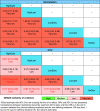A Network Meta-analysis of Dexamethasone for Preventing Postextubation Upper Airway Obstruction in Children
- PMID: 35976878
- PMCID: PMC9819263
- DOI: 10.1513/AnnalsATS.202203-212OC
A Network Meta-analysis of Dexamethasone for Preventing Postextubation Upper Airway Obstruction in Children
Abstract
Rationale: Periextubation corticosteroids are commonly used in children to prevent upper airway obstruction (UAO). However, the best timing and dose combination of corticosteroids is unknown. Objectives: To compare effectiveness of different corticosteroid regimens in preventing UAO and reintubation. Methods: MEDLINE, CINAHL, and Embase search identified randomized trials in children using corticosteroids to prevent UAO. All studies used dexamethasone. The studies were categorized based on timing of initiation of dexamethasone (early use: >12 h before extubation) and the dose (high dose: ⩾0.5 mg/kg/dose). We performed Bayesian network meta-analysis with studies grouped into four regimens: high dose, early use (HE); low dose, early use (LE); high dose, late use (HL); and low dose, late use. Results: Eight trials (n = 903) were included in the analysis. For preventing UAO (odds ratio; 95% credible interval), HE (0.13; 0.04-0.36), HL (0.39; 0.19-0.74), and LE (0.15; 0.04-0.58) regimens appear to be more effective than no dexamethasone (low certainty). HE and LE had the highest probability of being the top-ranked regimens for preventing UAO (surface under the cumulative ranking curve 0.901 and 0.808, respectively). For preventing reintubation, the effect estimate was imprecise for all four dexamethasone regimens compared with no dexamethasone (very low certainty). HE and LE were the top-ranked regimens (surface under the cumulative ranking curve 0.803 and 0.720, respectively) for preventing reintubation. Sensitivity analysis showed that regimens that started >12 hours before extubation were likely more effective than regimens started >6 hours before extubation. Conclusions: Periextubation dexamethasone can prevent postextubation UAO in children, but effectiveness is highly dependent on timing and dosing regimen. Early initiation (ideally >12 h before extubation) appears to be more important than the dose of dexamethasone. Ultimately, the specific steroid strategy should be personalized, considering the potential for adverse events associated with dexamethasone and the individual risk of UAO and reintubation.
Keywords: dexamethasone; extubation; meta-analysis; upper airway obstruction.
Figures





References
-
- Kurachek SC, Newth CJ, Quasney MW, Rice T, Sachdeva RC, Patel NR, et al. Extubation failure in pediatric intensive care: a multiple-center study of risk factors and outcomes. Crit Care Med . 2003;31:2657–2664. - PubMed
-
- Hawkins DB, Crockett DM, Shum TK. Corticosteroids in airway management. Otolaryngol Head Neck Surg . 1983;91:593–596. - PubMed
Publication types
MeSH terms
Substances
Grants and funding
LinkOut - more resources
Full Text Sources
Medical

